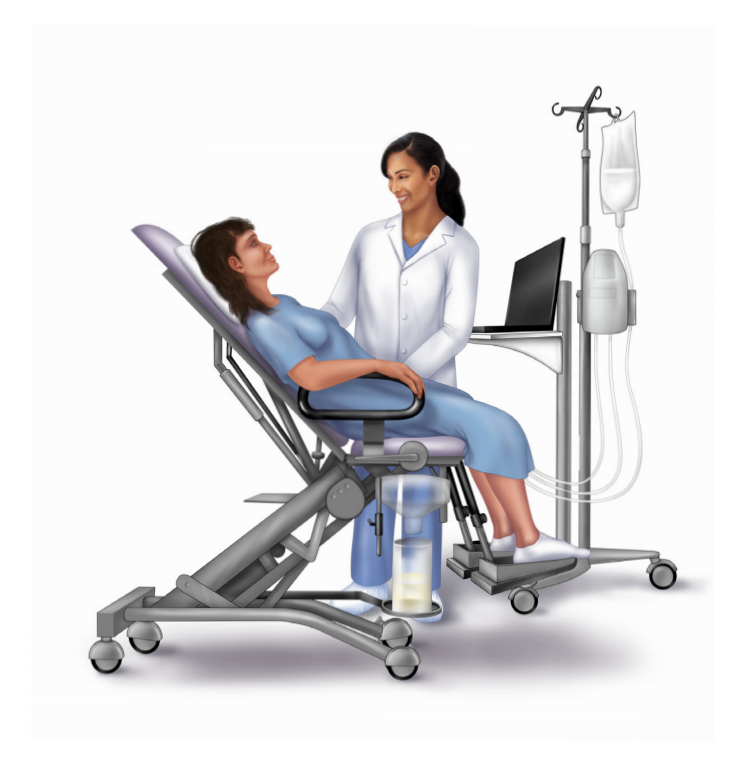Urodynamics is a series of tests that evaluate how well your bladder, urinary sphincter, and urethra work. These tests focus on how well your bladder fills and empties.
Bladder Function Tests
Your urologist or urogynecologist may recommend urodynamics, or urodynamic testing if you have:
- Urine leakage.
- Frequent urination.
- Painful urination.
- Sudden, strong urges to urinate.
- Problems starting a urine stream.
- Problems emptying the bladder completely.
Urodynamics is not usually painful, and most women do well. It can feel unusual to focus so much on urinating in a room with another person, but this test is very helpful to your care. No general anesthesia is required. You can drive yourself home afterward or return to work. Some results may be available immediately, or the results may take several days.
Before the Procedure
You may be asked to stop taking certain medicines in preparation for the procedure. Ask if there are things you should do before testing, such as:
- Stop taking certain medicines prior to the procedure.
- Arrive with a full bladder.
- Bring your voiding diary if you were asked to complete one.
You’ll undress from the waist down for the test:
- You’ll be given a gown or sheet for coverage.
- Occasionally, a topical numbing medicine is used.
- Testing lasts about 30 minutes.
LEARN THE TERMS
- Pelvic Organ Prolapse (POP): Dropping of the pelvic organs, such as the bladder, uterus, and rectum, caused by a loss of vaginal support.
- Urethra: Tube from the bladder to the outside of the body that urine passes through during urination.
- Urinary Incontinence: Any accidental leakage of urine.
- Urinary sphincter: Muscles around the urethra that help hold urine in the bladder.
- Urodynamics: A group of tests performed in the office using a machine to evaluate how well your bladder fills and empties.
Types of Urodynamic Tests
UROFLOWMETRY
First, you will sit down on the chair and urinate normally. This test measures how fast or slow the urine flows out of the bladder. It can determine if your bladder muscles are weak or the urine flow is blocked. A special collection device measures the volume and speed of the urine you pass.
POST-VOID RESIDUAL MEASUREMENT
Post-void residual is the amount of urine remaining in the bladder after you urinate. Everyone has a small amount of urine in the bladder after urination. If 5 to 6 ounces or more remains, your bladder is not emptying well. Post-void residual can be measured using ultrasound (a device called a bladder scanner) or with a thin, flexible tube (catheter).
CYSTOMETRICS
This part of the test measures:
- How well the bladder stores urine.
- Bladder pressure.
- How full the bladder is when you get that urge to go.
A very small catheter is placed into your bladder through your urethra. This catheter has pressure sensors. A second catheter is put into the vagina or rectum to measure the pressure inside the abdomen.
Your bladder is slowly filled with sterile water, which may feel cool. As this happens, you will say when your bladder feels a little full, almost full, and then completely full. Try to allow your bladder to fill as much as possible. You will be asked to cough and bear down to see if urine comes out. You may even stand up, jog, cough, and strain.
URETHRAL CLOSURE TESTING
During cystometrics, the catheter may be pulled through the urethra to measure the strength of the muscles that surround the urethra. You may be asked to cough during this process.
PRESSURE FLOW STUDY
The pressure flow study is a test for a potential blockage and to measure the strength of the bladder muscle. This test is done after cystometrics. You will be asked to empty your bladder with the catheter still in place. It measures how well the bladder muscle can squeeze when you are trying to urinate. It also measures the speed of the urine flow.
ELECTROMYOGRAPHY
Using special sensors, this test records muscle and nerve activity of the pelvic floor muscles, and/or bladder and urinary sphincters. These are usually stickers placed on your skin.
VIDEO URODYNAMIC TESTS
If you need additional testing, x-rays or ultrasound can be used to view how the bladder works. To take the x-ray, your bladder is filled with a special fluid (“contrast”) that shows up on an x-ray. For the ultrasound, warm water is filled into the bladder, and sound waves are used to take a photo of the bladder.
After the Procedure
After the test, you may notice stinging when you urinate. A warm bath or holding a warm or cool, damp washcloth over the urethral opening may offer some relief.
Urinary tract infections (UTIs) are uncommon after urodynamic testing, but you should call your provider if you have UTI symptoms. These include pain with urination, urinary odor, and voiding often.
Your provider may also recommend an over-the-counter medication to take if you are very bothered by the stinging or burning after the test.
THREE TAKEAWAYS
1. Most urodynamic tests measure how well the bladder holds and releases urine. If you leak urine, testing can help find the cause.
2. Review any special pre-test instructions, and plan to arrive with a full bladder.
3. Potential side effects include stinging when you urinate for a few days after the test.





